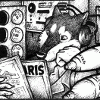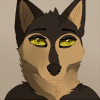
Prior to Nordenfeld declaration of independence and the Partition in late 5th century, Central Tractor and Agricultural Machinery Factory (CTAMF) in Norchester was tasked to develop a small, single seat 'agricultural' airplane for the purpose of 'crop dusting, top dressing and general land survey'. Development concluded in mid 570's and the resulting design, later known as the Nordenfeld F-1, was regarded as the first military aircraft to be designed and produced by the Nordenfeld empire.
During the war of independence the F-1 was used extensively for aerial reconnaissance and light bombing duty. Although the primitive F-1 was no match to United World Government legacy Aerodynes, UWG air forces soon suffers from irreplaceable attrition and lack of ammo and spare parts. In contrast, Nordenfeld factories keep chugging out new airplanes, spare parts and countless ammo for their newly formed armed forces. The UWG forces was soon pushed back south to what now known as Union of Non-Aligned States (UNAS) territory
Following the Nordenfeld independence, the F-1 was again deployed in the Partition War against the Carrenian republic. However, it was soon realized that a new, dedicated fighter aircraft was needed to counter threat from the newly founded Carrenian air force and so, the Nordenfeld F-2A was born. The F-2A, while sharing similar design with its predecessor, was lighter, nimbler, and featured more powerful engine and nose mounted synchronized machine guns making it a 'true' fighter aircraft. The deployment of F-2A expands the role of Imperial air force from aerial recconaissance and light air support, to establishing and maintaining air superiority over the battlefield and with it, the days of dogfighting had returned.
Further refinement to F-2 family was developed near the conclusion of hostilities, the all new F-3 / Canary featured full-cantilever all-metal wing structure, even larger engine, covered undercarriage and all-metal control surfaces, it was capable of taking twice the warload of F-2 for twice the range and substantial increase in airspeed. However, it entered service too late to saw any action and served as deterrent for most of its service life.
The F-3 was more widely known for its racer variant, the Nordenfeld R-3D / Canary IR. Its armament, bomb racks and other military equipments were completely stripped and the airframe is made lighter, the fuselage is further aerodynamically refined by making the cockpit fully enclosed and by cropping the rudder and vertical stabilizer, although with the cost of lateral stability - the R-3D was notorious for its spin characteristic, and many were lost to irrecoverable flat spins. nonetheless, the R-3D still became the centerpiece of every airshows and air races in early 600's
Although gaining momentum prior to the Partition, science and engineering development, including aviation, stagnated several decades after the Partition. Number of aviation firms and companies declined, and by 610's, Nordenfeld aviation is the only remaing big aviation company, despite beginning to cut costs.
In the midst of this stagnation, Firethorn Aircaft Co. was established.
Firethorn B-4 / Hawk light bomber was the first Firethorn aircraft to enter Imperial air force inventory. The B-4 was, by the time of its conception, the Imperial air force's heaviest single-engined aircraft. It used annular radiator in front of the engine, which gave an impression of radial engine although it used 840 hp V-12 engine. the bomber could carry stores of up to 750 kg and crew of three: pilot, bomb aimer/ventral gunner, and dorsal gunner. The Firethorn B-4 is the last of Imperial air force single-engined bomber.
For some variation, Novorossisch No-11TM is one example of unique Carrenian aircraft design from the 770 Border crisis. The No-11TM is basically two No-11 fighters joined together with port side cockpit replaced with a bomb bay, the left engine featured an additional gear in the propeller reduction box to allow the left propeller to turn opposite to the right propeller. The No-11TM was largely used for ground attack duty, although were fitted with 30mm autocannons and used as stop-gap heavy bomber destroyer near the end of war.
--
Sketches from last year, featuring some early aircraft of the Imperial air force and one unique specimen from the republic.
During the war of independence the F-1 was used extensively for aerial reconnaissance and light bombing duty. Although the primitive F-1 was no match to United World Government legacy Aerodynes, UWG air forces soon suffers from irreplaceable attrition and lack of ammo and spare parts. In contrast, Nordenfeld factories keep chugging out new airplanes, spare parts and countless ammo for their newly formed armed forces. The UWG forces was soon pushed back south to what now known as Union of Non-Aligned States (UNAS) territory
Following the Nordenfeld independence, the F-1 was again deployed in the Partition War against the Carrenian republic. However, it was soon realized that a new, dedicated fighter aircraft was needed to counter threat from the newly founded Carrenian air force and so, the Nordenfeld F-2A was born. The F-2A, while sharing similar design with its predecessor, was lighter, nimbler, and featured more powerful engine and nose mounted synchronized machine guns making it a 'true' fighter aircraft. The deployment of F-2A expands the role of Imperial air force from aerial recconaissance and light air support, to establishing and maintaining air superiority over the battlefield and with it, the days of dogfighting had returned.
Further refinement to F-2 family was developed near the conclusion of hostilities, the all new F-3 / Canary featured full-cantilever all-metal wing structure, even larger engine, covered undercarriage and all-metal control surfaces, it was capable of taking twice the warload of F-2 for twice the range and substantial increase in airspeed. However, it entered service too late to saw any action and served as deterrent for most of its service life.
The F-3 was more widely known for its racer variant, the Nordenfeld R-3D / Canary IR. Its armament, bomb racks and other military equipments were completely stripped and the airframe is made lighter, the fuselage is further aerodynamically refined by making the cockpit fully enclosed and by cropping the rudder and vertical stabilizer, although with the cost of lateral stability - the R-3D was notorious for its spin characteristic, and many were lost to irrecoverable flat spins. nonetheless, the R-3D still became the centerpiece of every airshows and air races in early 600's
Although gaining momentum prior to the Partition, science and engineering development, including aviation, stagnated several decades after the Partition. Number of aviation firms and companies declined, and by 610's, Nordenfeld aviation is the only remaing big aviation company, despite beginning to cut costs.
In the midst of this stagnation, Firethorn Aircaft Co. was established.
Firethorn B-4 / Hawk light bomber was the first Firethorn aircraft to enter Imperial air force inventory. The B-4 was, by the time of its conception, the Imperial air force's heaviest single-engined aircraft. It used annular radiator in front of the engine, which gave an impression of radial engine although it used 840 hp V-12 engine. the bomber could carry stores of up to 750 kg and crew of three: pilot, bomb aimer/ventral gunner, and dorsal gunner. The Firethorn B-4 is the last of Imperial air force single-engined bomber.
For some variation, Novorossisch No-11TM is one example of unique Carrenian aircraft design from the 770 Border crisis. The No-11TM is basically two No-11 fighters joined together with port side cockpit replaced with a bomb bay, the left engine featured an additional gear in the propeller reduction box to allow the left propeller to turn opposite to the right propeller. The No-11TM was largely used for ground attack duty, although were fitted with 30mm autocannons and used as stop-gap heavy bomber destroyer near the end of war.
--
Sketches from last year, featuring some early aircraft of the Imperial air force and one unique specimen from the republic.
Category All / All
Species Unspecified / Any
Size 1280 x 573px
File Size 111.3 kB

 FA+
FA+














Comments